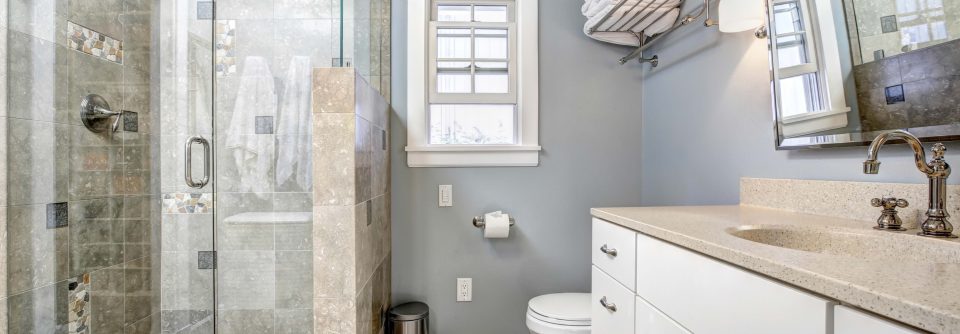
Never Make These Mistakes Painting Your Bathroom
Posted on March 25, 2019
Bathrooms are a difficult room to renovate. There are irremovable pieces and humidity to deal with. That makes the paint on the walls all the more important. It has the potential to save your walls from the harsh effects of water. From our experts, never make these mistakes painting your bathroom.
There are loads of options when it comes to paint, as well as a wide spread price gap. When choosing your new color, remember the most important piece of bathroom paint is the finish.
There are no other rooms in your home that will produce the amount of dampness as your bathroom does. Bathrooms are abused by users beyond the water. Flying toothpaste, shaving cream and other yuckiness hits walls and makes a mess of your paint.
By choosing a shiny finish, you are ensured the ability to repel water and make necessary clean ups. The finish will avoid mildew and mold, and help keep stains from setting in.
From there, here are mistakes to avoid when painting your bathroom.
1. Lack of prep work.
A lot of headaches can be avoided with a little prep work. There is so much to paint around in a small space like a bathroom, spending time to tape, wrap and cover will save you clean up and repair work in the end. Remove any switch covers and wall items. Wrap door knobs and tape off trim. The work in the beginning of the project will make the painting take less time and result better.
2. Invest in painter’s tape.
Taping the edges of your sink, vanity, cabinets and plumbing is crucial. To get a clean edge and solid line, press the tape down with a putty knife. This will ensure you don’t have bleed through. When the paint dries, use a box cutter to let the edge loose and keep paint from pulling up with your tape.
3. Not washing the walls.
Your bathroom walls are sure to have water on them after a shower. Surely, they are clean, right? Wrong. Take time to wipe down any dampness, crud and dust that have landed on your walls. A rogue splash of lotion or splatter of water can ruin a good paint job. Vacuum the walls. Degrease them. Use a mixture of one gallon of warm water and two cups of vinegar and a rag to wipe them down. Don’t miss corners and floor boards.
4. Under buying paint.
Avoid running to the store mid project buy getting extra paint. Even with the most advanced mixing tools, variations in paint can occur. It’s better to buy one big batch and deal with the extra. You’ll have a bit for touch ups or if a holiday appears after a couple days of drying. Normally, a gallon of paint covers about 400 square feet. Working from that number, over order.
5. Buying the cheapest tools.
Getting the right brush for you paint will make a difference in the overall look of your project. Buy according to paint type and use. For latex paint, get a synthetic bristle brush. If you are using oil-based paint, you will need a natural bristle brush. After purchasing good quality paint and putting in the time and effort, don’t throw away your project on a cheap brush. Spend a bit extra and ensure your paint comes out nice.
6. Grabbing the on sale paint.
No matter what is on sale, don’t risk the paint of your bathroom by purchasing the wrong paint. If you are painting over a coat, as most of us are, you need to know what you are painting onto. Your layers must be compatible. Latex paint on top of oil? Cracking and peeling are headed your way. If you are unsure of your paint type currently on the walls. Take a sample to the paint department. They will be able to send you the right direction.
7. Primer is crucial.
Primer creates a bonding layer between your paint and the wall. It is especially important when painting over another color or in a particularly humid room, read: bathroom. Primer will enhance the color of the paint you have chosen will helping to create a lustrous finish.
8. Rushing the second coat.
When your paint is not quite set and you move forward with another coat of paint, you can create holidays, streaks and other issues within your paint. You must wait for complete drying in between coats. If you are not sure how long to wait, the best bet is 24 hours between.





